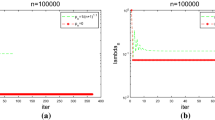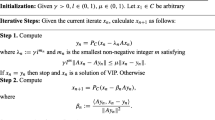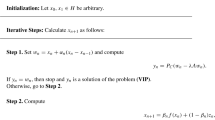Abstract
In this paper, we study the approximation problem of solutions for the semistrictly quasi-monotone variational inequalities in infinite-dimensional Hilbert spaces. We prove that the iterative sequence generated by the algorithm for solving the semistrictly quasi-monotone variational inequalities converges weakly to a solution.
Similar content being viewed by others
1 Introduction
The theory of variational inequalities serves as a powerful mathematical tool, which unifies important concepts in applied mathematics like systems of nonlinear equations, optimality conditions for optimization problems, complementarity problems, obstacle problems, and network equilibrium problems. Therefore, this theory has numerous applications in the fields of engineering, mathematical programming, network economics, transportation research, game theory, and regional sciences [1, 2, 13, 14, 16]. Several techniques for solving a variational inequality in infinite-dimensional spaces (such as projection method, extragradient method, Tikhonov regularization method and proximal point method) have been suggested; see, e.g., [7, 9]. The well-known gradient projection method can be successfully applied for solving strongly monotone variational inequalities and inverse strongly monotone variational inequalities [5, 7, 12, 17, 19]. The Tikhonov regularization and proximal point methods can serve as an efficient solution method for solving monotone variational inequalities. Korpelevich introduced the extragradient method [15], and this method was applied for solving monotone variational inequalities in infinite-dimensional spaces. It is a known fact [7] that the extragradient method can be successfully applied for solving monotone variational inequalities. Recently, the extragradient method has been considered for solving variational inequalities in infinite-dimensional Hilbert spaces [3, 4, 10, 18]. It is proved that if the variational inequality has solutions and the assigned mapping is monotone and Lipschitz continuous, then the iterative sequence generated by the extragradient method converges weakly to a solution.
The aim of this paper is to study the approximation problem of solutions for the semistrictly quasi-monotone variational inequalities in infinite-dimensional Hilbert spaces. We prove that the iterative sequence generated by the extragradient method for solving semistrictly quasi-monotone variational inequalities converges weakly to a solution.
2 Preliminaries
Throughout this article we assume that \(\mathcal{H}\) is a real Hilbert space with inner product \(\langle \cdot ,\cdot \rangle \) and induced norm \(\|\cdot \|\) and \(\mathcal{C}\) is a nonempty, closed and convex subset of \(\mathcal{H}\).
For each \(u \in \mathcal{H}\), there exists a unique point in \(\mathcal{C}\), denoted by \(P_{\mathcal{C}}(u)\), such that
The operator \(P_{C}\) is called the projection operator from \(\mathcal{H}\) onto \(\mathcal{C}\). It is well known [13] that the projection operator can be characterized by
If \(P_{\mathcal{C}}\) is a projection operator of \(\mathcal{H}\) onto \(\mathcal{C}\), then
Let \(Q:\mathcal{C} \longrightarrow \mathcal{H}\) be a mapping. The variational inequality \(VI(\mathcal{C},Q)\) defined by \(\mathcal{C}\) and Q is to find a point \(u^{\ast }\in \mathcal{C}\) such that
The solution set of (2.2) is denoted by \(\operatorname{Sol}( \mathcal{C},Q)\).
It is known (see, for instance, [6]) that the previous problem is closely related to finding a point \(u^{\ast }\in \mathcal{C}\) such that
Following [6], we shall call problem (2.3) the dual variational inequality problem (\(\operatorname{DVI}(\mathcal{C}, Q)\)) of (2.2).
Definition 2.1
A mapping \(Q:\mathcal{H}\longrightarrow \mathcal{H}\) is said to be
-
(a)
weakly hemicontinuous if Q is upper semicontinuous from line segments in \(\mathcal{H}\) to the weak topology of \(\mathcal{H}\);
-
(b)
sequentially weakly continuous if for each sequence \(\{u_{n}\}\) in \(\mathcal{H}\) with \(\{u_{n}\}\rightharpoonup u\) (\(\{u _{n}\}\) converges weakly to u), \(\{Q(u_{n})\}\) converges weakly to \(Q(u)\).
Remark 2.2
It is easy to prove that if \(Q:\mathcal{H}\longrightarrow \mathcal{H}\) is sequentially weakly continuous, then Q must be weakly hemicontinuous.
It is well known that the following conclusion holds
Lemma 2.3
([6])
A solution of \(\operatorname{DVI}(\mathcal{C},Q)\) is always a solution of \(VI( \mathcal{C},Q)\), provided that the operator Q is, say, weakly hemicontinuous.
This is why we shall restrict our attention to \(\operatorname{DVI}(\mathcal{C},Q)\).
Remark 2.4
It is well-known that \(u^{\ast }\in \mathcal{C}\) is a solution of (2.2) if and only if \(u^{\ast }= P_{\mathcal{C}}(u^{\ast }- \lambda Q(u^{\ast }))\) for all \(\lambda > 0\).
Let \(\mathcal{H}\) be a real Hilbert space. Given \(x, y \in \mathcal{H}\), we define the closed line segment
The segments \((x, y]\), \([x,y)\), and \((x, y)\) are defined analogously.
Definition 2.5
Let \(\mathcal{C}\) be a nonempty and closed convex subset in \(\mathcal{H}\), and let \(Q:\mathcal{C}\longrightarrow \mathcal{H}\) be a mapping. The mapping Q is said to be:
-
(a)
strongly monotone on \(\mathcal{C}\) with constant \(\tau >0\) if for each pair of points \(u, v \in \mathcal{C}\), we have
$$ \bigl\langle Q(u) - Q(v), u - v\bigr\rangle \geq \tau \Vert u-v \Vert ^{2}; $$ -
(b)
strictly monotone on \(\mathcal{C}\) if for all distinct \(u, v \in \mathcal{C}\), we have
$$ \bigl\langle Q(u) - Q(v), u - v\bigr\rangle > 0; $$ -
(c)
monotone on \(\mathcal{C}\) if for each pair of points \(u, v \in \mathcal{C}\), we have
$$ \bigl\langle Q(u) - Q(v), u - v\bigr\rangle \geq 0; $$ -
(d)
pseudo-monotone on \(\mathcal{C}\) if for each pair of points \(u, v \in \mathcal{C}\), we have
$$ \bigl\langle Q(v), u - v\bigr\rangle \geq 0 \quad \Rightarrow\quad \bigl\langle Q(u), u - v \bigr\rangle \geq 0; $$ -
(e)
quasi-monotone on \(\mathcal{C}\) if for each pair of points \(u, v \in \mathcal{C}\), we have
$$ \bigl\langle Q(v), u - v\bigr\rangle > 0 \quad \Rightarrow\quad \bigl\langle Q(u), u - v \bigr\rangle \geq 0; $$ -
(f)
(see [8]) semistrictly quasi-monotone on \(\mathcal{C}\) if Q is quasi-monotone on \(\mathcal{C}\) and for all distinct of points \(u, v \in \mathcal{C}\), we have that
$$ \bigl\langle Q(v), u - v\bigr\rangle > 0 \quad \text{implies}\quad \bigl\langle Q(z), u - v \bigr\rangle > 0, \quad \text{for some } z\in \bigl(0.5(u+v),u\bigr). $$
Remark 2.6
The following implications hold:
But the reverse assertions are not true, in general.
Lemma 2.7
-
(i)
Each pseudo-monotone mapping Q on \(\mathcal{C}\) is semistrictly quasi-monotone on \(\mathcal{C}\).
-
(ii)
If Q is quasi-monotone and affine on \(\mathcal{H}\), i.e., \(Q(u)=Mu+q\), where \(q \in \mathcal{H}\), and M is a linear and bounded operator on \(\mathcal{H}\), then Q is semistrictly quasi-monotone on \(\mathcal{H}\).
Proof
(i) Suppose on the contrary that, for given \(u, v \in \mathcal{C}\) with \(u \neq v\), we have
Since \(z \in (0.5(u+v),u)\), it can be written as
This implies that \(v -z = (1- \frac{1}{2}t)(v-u)\). Hence we have
By the pseudo-monotonicity of Q, it follows that
Hence we have
which is a contradiction.
(ii) If \(u, v \in \mathcal{H} \), with \(u \neq v\), are such that \(\langle Mv + q, u-v\rangle > 0\), then, by the quasi-monotonicity of Q, we have
Set \(u_{\lambda }= \lambda v + (1 -\lambda )u\). It follows that
Hence it holds for some \(\lambda \in (0, 0.5)\). For example, take \(\lambda = 0.3\), then \(u_{0.3} \in (0.5(u+v), u)\) and \(\langle M(u _{0.5})+q,u- v\rangle > 0\).
This completes the proof. □
Proposition 2.8
([14])
Let \(\mathcal{C}\) be a nonempty, closed and convex subset of \(\mathcal{H}\) and \(Q : \mathcal{C} \longrightarrow \mathcal{H}\) be a weakly hemicontinuous and semistrictly quasi-monotone mapping. Then \(\operatorname{DVI}(\mathcal{C},Q)\) (2.3) at least has one solution.
3 Weak convergence theorem
In this section, we consider the problem \(VI(\mathcal{C},Q)\) with \(\mathcal{C}\) being a nonempty, closed, convex subset of \(\mathcal{H}\), and Q being semistrictly quasi-monotone on \(\mathcal{H}\) and ζ-Lipschitz continuous with \(\zeta > 0\) on \(\mathcal{C}\).
Algorithm 3.1
Data: \(u^{0} \in \mathcal{C}\) and \(\{\lambda _{\ell }\} \in [a,b]\), where \(0 < a \leq b < \frac{1}{\zeta }\).
Step 0: Set \(\ell = 0\).
Step 1: If \(u^{\ell }= P_{\mathcal{C}} (u^{\ell }- \lambda _{\ell }Q(u^{\ell }))\) then stop.
Step 2: Otherwise, set
Replace ℓ by \(\ell + 1\); go to Step 1.
Remark 3.2
Assume that \(Q(u^{\ell }) = 0\), then
and Algorithm 3.1 terminates at step ℓ with a solution \(u^{\ell }\).
Therefore, without loss of generality, we can assume that \(Q(u^{ \ell })\neq0\) for all ℓ, so that Algorithm 3.1 generates an infinite sequence.
Lemma 3.3
Assume that Q is semistrictly quasi-monotone and ζ-Lipschitz continuous on \(\mathcal{C}\) and \(\operatorname{Sol}(\mathcal{C},Q)\) is nonempty. Let \(u^{\ast }\) be a solution of \(VI(\mathcal{C},Q)\). Then, for every \(\ell \in N\), we have
Theorem 3.4
Assume that Q is semistrictly quasi-monotone on \(\mathcal{H}\), sequentially weakly continuous and ζ-Lipschitz continuous on \(\mathcal{C}\). Then, the sequence \(\{u^{\ell }\}\) generated by Algorithm 3.1 converges weakly to a solution of \(VI(\mathcal{C},Q)\).
Proof
First we point out that, by the assumptions of Theorem 3.4, Remark 2.2, Lemma 2.3 and Proposition 2.8, we know that the solution set \(\operatorname{Sol}(\mathcal{C},Q)\) is nonempty.
Since \(0 < a \leq \lambda _{\ell }\leq b < \frac{1}{\zeta }\), it holds that
From Lemma 3.3, the sequence \(\{u^{\ell }\}\) is bounded and
Since Q is Lipschitz continuous on \(\mathcal{C}\), we have
Hence
Since \(\{u^{\ell }\}\) is a bounded sequence in \(\mathcal{H}\), there exists a subsequence \(\{u^{\ell _{i}}\}\) of \(\{u^{\ell }\}\) converging weakly to \(\hat{u} \in \mathcal{C}\). Therefore
also \(\{\bar{u}^{\ell _{i}}\}\) converges weakly to û.
Next we will show that û∈\(\operatorname{Sol}(\mathcal{C},Q)\).
In fact, since
by the projection characterization (2.1), it follows that
or equivalently,
This implies that
Fixing \(v \in \mathcal{C}\), letting \(i \longrightarrow +\infty \) in the latter inequality, as well as remembering that
and \(\lambda _{\ell }\in [a, b] \subset \,]0, \frac{1}{\zeta }[\) for all ℓ, we have
Now we choose a sequence \(\{\epsilon _{i}\}\) of positive numbers decreasing to 0. For each \(\epsilon _{i}\), we denote by \(n_{i}\) the smallest positive integer such that
where the existence of \(n_{i}\) follows from (3.3). Since \(\{\epsilon _{i}\}\) is decreasing, it is easy to see that sequence \(\{n_{i}\}\) is increasing. Furthermore, for each i, \(Q(u^{\ell _{n _{i}}})\neq 0\) and, setting
we have
It follows from (3.4) that for each i,
Since Q is semistrictly quasi-monotone, we have
On the other hand, since \(\{u^{\ell _{i}}\}\) converges weakly to û as \(i \longrightarrow \infty \), and Q is sequentially weakly continuous on \(\mathcal{C}\), it follows that \(\{Q(u^{\ell _{i}})\}\) converges weakly to \(Q(\hat{u})\). We can suppose that \(Q(\hat{u}) \neq 0\) (otherwise, û is a solution). Since the norm \(\|\cdot \|\) is sequentially weakly lower semicontinuous, we have
Since \(\{u^{\ell _{n_{i}}}\} \subset \{u^{\ell _{i}}\}\) and \(\epsilon _{i} \longrightarrow 0\) as \(i \longrightarrow 0\), we obtain
Taking the limit as \(i \longrightarrow \infty \) in (3.5), we get
It follows from Lemma 2.3 and Remark 2.4 that û∈ \(\operatorname{Sol}(\mathcal{C}, Q)\).
Finally, we show that sequence \(\{u^{\ell }\}\) converges weakly to û. To do this, it is sufficient to show that \(\{u^{\ell }\}\) cannot have two distinct weak sequential limit points in \(\operatorname{Sol}( \mathcal{C},Q)\). Let \(\{u^{\ell _{j}}\}\) be another subsequence of \(\{u^{\ell }\}\) converging weakly to ū. We have to prove that \(\hat{u} = \bar{u}\). As it has been proven above, ū∈ \(\operatorname{Sol}(\mathcal{C},Q)\). From Lemma 3.3, the sequences \(\{\|u^{\ell }- \hat{u}\|\}\) and \(\{\|u^{\ell }- \bar{u}\|\}\) are monotonically decreasing and therefore converge. Since, for all \(\ell \in N\),
we deduce that sequence \(\{\langle u^{\ell }, \bar{u} - \hat{u}\rangle \}\) also converges. Setting
and passing to the limit along \(\{u^{\ell _{i}}\}\) and \(\{u^{\ell _{j}} \}\) yields
This implies that \(\|\hat{u} - \bar{u}\|^{2} = 0\), and therefore \(\hat{u} = \bar{u}\). □
4 A numerical example
We consider a mapping Q which is semistrictly quasi-monotone but not monotone.
Let \(\mathcal{H} = l_{2}\) be the real Hilbert space whose elements are the square-summable sequences of real numbers, i.e., \(\mathcal{H} = \{u = (u_{1}, u_{2}, \dots , u_{i},\dots ):\sum^{\infty } _{i=1}| u_{i} | ^{2} < +\infty \}\). Let \(\alpha , \beta \in \mathbb{R}\) be such that \(\beta > \alpha > \frac{\beta }{2}> 0\). Put
where α and β are parameters. It is easy to see that \(Q_{\beta }\) is sequentially weakly continuous on \(\mathcal{H}\) and \(\operatorname{Sol}(\mathcal{C}_{\alpha }, Q_{\beta }) = \{0\}\).
Next we prove that \(Q_{\beta }: \mathcal{C}_{\alpha }\longrightarrow \mathcal{H} \) is Lipschitz continuous and semistrictly quasi-monotone on \(\mathcal{C}_{\alpha }\). In fact, for any \(u,v \in \mathcal{C}_{ \alpha }\), we have
Hence, \(Q_{\beta }\) is Lipschitz continuous on \(\mathcal{C}_{\alpha }\) with the Lipschitz constant \(\zeta = \beta + 2\alpha \). Let \(u,v \in \mathcal{C}_{\alpha }\) be such that
Then
Since \(\|u\| \leq \alpha < \beta \), we have
Hence,
Thus, we shown that \(Q_{\beta }\) is semistrictly quasi-monotone on \(\mathcal{C}_{\alpha }\). It is worthy to stress that \(Q_{\beta }\) is not monotone on \(\mathcal{C}_{\alpha }\). To see this, it suffices to choose \(u = (\frac{\beta }{2}, 0, \dots ,0, \dots )\), \(v = (\alpha , 0, \dots ,0,\dots ) \in \mathcal{C}_{\alpha }\) and note that
Using the extragradient method for solving the semistrictly quasi-monotone variational inequality VI\((\mathcal{C}_{\alpha }, Q_{\beta })\), we choose \(\lambda _{\ell }= \lambda \in (0,\frac{1}{ \zeta })=(0, \frac{1}{\beta +2\alpha })\) and any \(u^{0} \in \mathcal{C}_{\alpha }\) as a starting point. The projection onto \(\mathcal{C}_{\alpha }\) is explicitly calculated as
Since, for all ℓ,
we have
Therefore,
Similarly, we can deduce that
Indeed, we have
Since
we can write
This and (4.1) imply that
We have
Considering the function \(q(x)=\beta -(1 - \lambda \beta )x -\lambda x^{2}\) with \(x \in [0, \alpha ]\), it is easy to see that q is decreasing on \([0, \alpha ]\). Therefore, the minimal value of q is
which is attained at \(x = \alpha \). Combining this with (4.3) and (4.2) yields
We claim that
Indeed, since \(\alpha < \beta \) and \(0 < \lambda < \frac{1}{\beta +2 \alpha }\), we have \(\varrho > 0\). To verify that \(\varrho < 1\), it is sufficient to show that \((\beta - \alpha ) \lambda (1 + \alpha \lambda ) < 1\). Since \(\frac{\beta }{2} < \alpha < \beta \) and \(0 < \lambda <\frac{1}{ \beta +2\alpha }\), we have
This implies that \(\varrho \in (0,1)\), and we can deduce from (4.4) that
This means that the sequence \(\{u^{\ell }\}\) converges strongly to 0, the unique solution of VI\((\mathcal{C}_{\alpha }, Q_{ \beta })\).
References
Agarwal, R.P., Ahmad, M.K., Salahuddin: Existence of solutions to weakly generalized vector F-implicit variational inequalities. Discontinuity, Nonlinearity, Complexity 1(3), 225–235 (2012)
Agarwal, R.P., Ahmad, M.K., Salahuddin: Hybrid type generalized multivalued vector complementarity problems. Ukr. Math. J. 65(1), 6–20 (2013)
Censor, Y., Gibali, A., Reich, S.: The subgradient extragradient method for solving variational inequalities in Hilbert space. J. Optim. Theory Appl. 148, 318–335 (2011)
Censor, Y., Gibali, A., Reich, S.: Strong convergence of subgradient extragradient methods for the variational inequality problem in Hilbert space. Optim. Methods Softw. 26, 827–845 (2011)
Censor, Y., Gibali, A., Reich, S.: Extensions of Korpelevich extragradient method for the variational inequality problem in Euclidean space. Optimization 61, 1119–1132 (2012)
Daniilidis, A., Hadjisavvas, N.: Characterization of nonsmooth semistrictly quasiconvex and strictly quasiconvex functions. J. Optim. Theory Appl. 102, 525–536 (1999)
Facchinei, F., Pang, J.-S.: Finite-Dimensional Variational Inequalities and Complementarity Problems, Vols. I and II. Springer, New York (2003)
Hadjisavvas, N., Chaible, S.: On strong pseudomonotonicity and (semi)strict quasimonotonicity. J. Optim. Theory Appl. 79(1), 139–155 (1993)
Karamardian, S., Schaible, S.: Seven kinds of monotone maps. J. Optim. Theory Appl. 66, 37–46 (1990)
Khanh, P.D.: A new extragradient method for strongly pseudomonotone variational inequalities. Numer. Funct. Anal. Optim. 37, 1131–1143 (2016)
Khanh, P.D.: A modified extragradient method for infinite-dimensional variational inequalities. Acta Math. Vietnam. 41, 251–263 (2016)
Kim, J.K., Salahuddin, Lim, W.H.: An iterative algorithm for generalized mixed equilibrium problems and fixed points of nonexpansive semigroups. J. Appl. Math. Phys. 5, 276–293 (2017)
Kinderlehrer, D., Stampacchia, G.: An Introduction to Variational Inequalities and Their Applications. Academic Press, New York (1980)
Konnov, I.V.: On quasimonotone variational inequalities I. J. Optim. Theory Appl. 99(1), 165–181 (1998)
Korpelevich, G.M.: The extragradient method for finding saddle points and other problems. Metody 12, 747–756 (1976)
Lee, B.S., Salahuddin: Scalarization techniques for set valued vector variational type inequalities. Arch. J. Math. 2(2), 121–129 (2012)
Tam, N.N., Yao, J.-C., Yen, N.D.: Solution methods for pseudomonotone variational inequalities. J. Optim. Theory Appl. 138, 253–273 (2008)
Vuong, P.T.: On the weak convergence of the extragradient method for solving pseudo-monotone variational inequalities. J. Optim. Theory Appl. 176, 399–409 (2018)
Zhu, D.L., Marcotte, P.: Co-coercivity and its role in the convergence of iterative schemes for solving variational inequalities. SIAM J. Control Optim. 6, 714–726 (1996)
Acknowledgements
We would like to express our thanks to the anonymous referees and the editor for their constructive comments and suggestions, which greatly improved this article.
Availability of data and materials
Not applicable.
Funding
This work was supported by the National Natural Science Foundation of China (Grant 11361070) and supported by the Scientific Research Fund of Science and Technology Department of Sichuan Province (No. 2018-JY0340). This work was also supported by the Natural Science Foundation of Center for General Education, China Medical University, Taichung, Taiwan.
Author information
Authors and Affiliations
Contributions
All authors contributed equally and significantly in writing this article. All authors read and approved the final manuscript.
Corresponding author
Ethics declarations
Competing interests
The authors declare that there is no conflict of interest regarding the publication of this paper.
Additional information
Publisher’s Note
Springer Nature remains neutral with regard to jurisdictional claims in published maps and institutional affiliations.
Rights and permissions
Open Access This article is distributed under the terms of the Creative Commons Attribution 4.0 International License (http://creativecommons.org/licenses/by/4.0/), which permits unrestricted use, distribution, and reproduction in any medium, provided you give appropriate credit to the original author(s) and the source, provide a link to the Creative Commons license, and indicate if changes were made.
About this article
Cite this article
Chang, S.S., Salahuddin, Wang, L. et al. On the weak convergence for solving semistrictly quasi-monotone variational inequality problems. J Inequal Appl 2019, 74 (2019). https://doi.org/10.1186/s13660-019-2032-8
Received:
Accepted:
Published:
DOI: https://doi.org/10.1186/s13660-019-2032-8




